HDR, A Wedding

|
• Deira Park Hotel • Khalidia Hotel Apartments • Le Meridien Residence Baniyas Square • Traders Hotel Dubai |
Feature Photograph

Weddings! This week we’ll be seeing some great wedding shots from Rob over at www.1ds.com in our Weekly Outing Section. Looking at his images I found myself really admiring his work. He covered most of the traditional types of shots really well. Rob doesn’t claim to be a wedding photographer, and covering a wedding is not an easy thing to do, but he sure did a great job of this one!
As you gain experience shooting weddings and start nailing the traditional and expected images you start bringing more to your game. You start seeing great shots that you might have missed before, you start using different lighting techniques, and then there’s the candid’s. This weeks feature photograph is topical for this reason. Often, in the early years when I did weddings, I’d have customers tell me I did a fine job but I wasn’t getting the reaction I was really after. Really what I was doing in those early years was just covering the basics and feeling damn lucky I didn’t screw things up. Actually, I still feel damn lucky when I don’t screw up a wedding because they’re that important to the wedding couple.
When I became more comfortable and found myself relaxing more I started looking for those occasional candid shots usually missed. I learned through experience that the candid shots, the silly faces, the mistakes, the open fly.. these brought ‘life’ to the wedding album and brought the biggest smiles to the faces of the couple as they were soft proofing their wedding. The laughter would start, the hearts would warm, and they’d leave having had a great time viewing the pictures vs. leaving having completed a business transaction. This is the point where I started to feel really good about my work, simply because I was making others feel really good viewing my work.
In the picture above I had the couple posing against a very drab background because it’s all we had. The temp was over 40c, everyone was sweating and overheated, and the setting was in a very dusty and not very attractive setting. I used a sepia effect for the couple while de-saturating the background to mask/hide the poor background. I had them posing in their formal poses and while I was directing their poses I’d make jokes and make them feel at ease and laugh a bit. They’d hold very still for the posed shots and once they heard the shutter click they’d immediately loosen up and the natural expressions of joy and love you feel during a wedding would appear. My technique for capturing such moments is to simply shoot continuous frames at about 3fps. Each time I pushed the shutter release I held it down for long enough to capture a burst of 4-5 images. Every 4-5 poses you’d get something really special as the couple loosens up and isn’t expecting the camera to capture them.
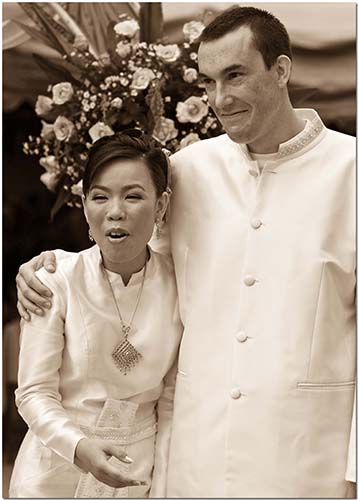
A wedding is all about emotions and the more emotions your pictures show the better. At least so far this has worked for me and pleased my clients more than even my most perfect traditional shots. Don’t get me wrong, if I didn’t produce those perfect traditional shots they’d be hopping mad and rightfully so. It’s just that the emotional candid’s.. they’re the icing on the wedding cake!
Weekly Photo Outing
This weeks Photo Outing will be guest written by Rob over at www.1ds.com. Rob has contributed to this weekly several times (remember the amazing tiger and Great Wall shots?) and his work is always appreciated and admired. Thank you Rob! This week Rob brings us a real treat, photos and insight into a Thai wedding which he apparently did a great job of covering.
A Wedding
Well time goes by, and young ones grow up. This is evidenced in a large family of girls / ladies, when they start getting married off and living their own lives. This time it was Sao's younger sister "Em"'s turn at the threshold (mental note here, not sure what one would call it in Buddhist terms….. Please email me and let me know)
As usual, it's wake up before the roosters for a Thai wedding. In fact, some of them stayed awake all night. Em was out early to get her makeup and hair done. The event kicked off downstairs at 7am sharp (in Thai terms) and therefore plenty of preparation time was needed.
The family had arrived early to prepare the feast and to set up for the guests, speeches and other formalities.
I've been asked to take the photos along with Sao. This is an ominous responsibility, as you only get one go at it.
The Roosters started to crow and Em popped out for the first time. It was almost hard to recognise her in that attire. The light was soft and we were upstairs and I was stalking her for some shots.
For the first, pre-wedding lot, I wanted to get some of that juicy light coming in through the doors and windows.
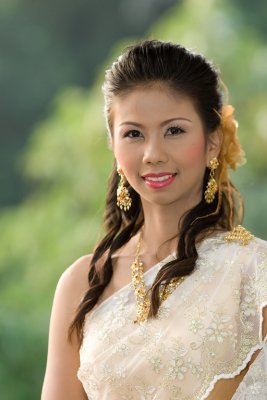
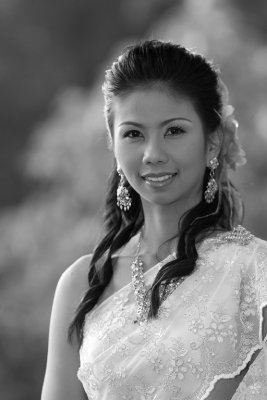
One of my techniques was to use B&W in my post processing. I like the understated look of the B&W, makes it quite elegant. Others thought it needed more contrast and processing. Almost everyone thought that the colour one was better.
The monks arrived "en force" into the areas set up for them. As in all of these events, we had some facilitators that guide the participants through the process. Like a western wedding, there are the basics and there are the bits that they make up as they go along. This day was no different and I saw a few things that were not normal to me.
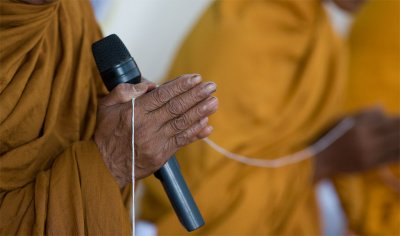
The monks proceeded, with the aid of the facilitator, to chant and go through the myriad of processes needed to correctly bless the loving couple. After an hour you can see that sitting on their knees (the Bride and Groom) is getting uncomfortable, man I know this feeling! In the photo above you can see the string connecting all of the Monks as one, it also connected to the Buddha setup in the corner, and over to the Bride and Groom. If I am not mistaken, the people sitting in and around the room also got into the string deal. Apparently it makes you all as one for the blessings, or something like that. Don't try and ask anyone, there will seventeen different answers.
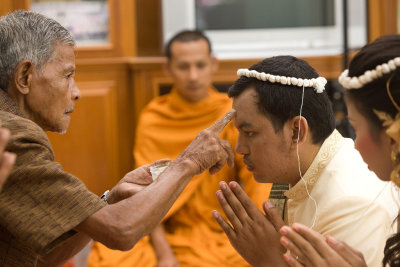
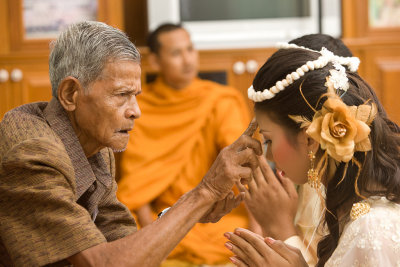
The facilitator took the blessed chalk dust (I cannot describe it in a better way…. there is a Thai word for it, probably "Chalk dust") which was mixed with the holy water (Blessed water that has candles melted into it… don't ask!!) to make a paste. This is then planted in formal dots and shapes on the Bride and Grooms foreheads.
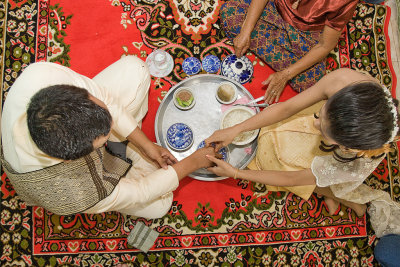
Next we had a feeding ritual. This was new to me. They had to feed each other. I remember feeding the Monks (well, giving them food), but this was new.
I used an overhead technique to make it more interesting.
The Facilitator always seems to be an older chap who's been there done that.
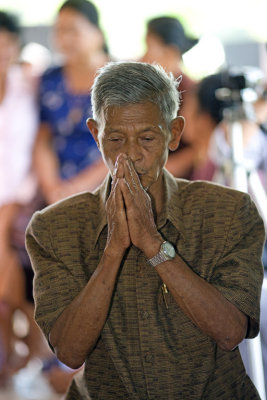
I took this picture with some fill flash. It was challenging due to the background lighting. I like the way he's halo'd by the light.
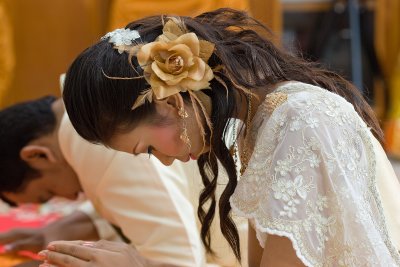
Em and Ek (Egg) show respect to the Monks through the process.
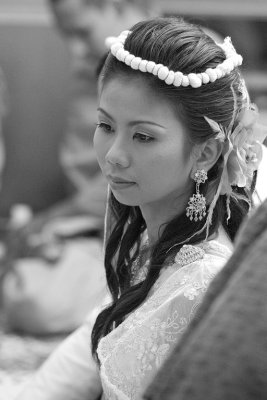
Em takes a breath through the proceedings. It's a tiring day!! And a long one! I preferred Black and white here for some reason.
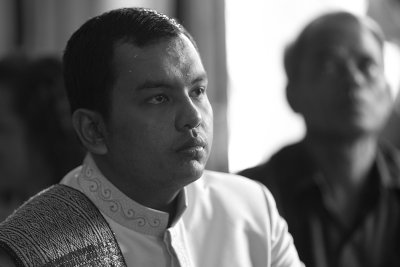
I thought the Groom could look happier. Again I liked B&W here for the mood, and it represented the action better somehow…. (Blinking action)
So here's a quick look at Em & Ek's Wedding day in Surat Thani. 2008!!
Enjoy!
High Dynamic Range (HDR)
This is another topic for advanced users but perhaps one everyone will enjoy. There is one inherent problem with digital that the camera manufacturers have been unable to address so far. The problem is even the best digital sensors used in the most expensive digital cameras made, do not have the dynamic range (the range from the brightest to the darkest point) of even the cheapest film. This means when the scene has a range of light that exceeds the dynamic range of the sensor, that you must compromise your exposure to clip either the highlights or the shadows. This severely reduces tonal range and it almost becomes a matter of luck to get the rich tones you’re used to seeing with film. This isn’t a problem with most scenes, but it is a problem with the most beautiful landscapes and this is why some of the best landscape photographers are still using 4×5 and 8×10 films.
There is a digital solution! However, it takes a bit of work. Using a program like Photomatrix from HDRsoft you can combine images of the same scene taken at different exposures and drastically increase your dynamic range.

Notice the three images above? Each a different exposure. If you combine them in Photomatrix you can increase the dynamic and tonal range and get the resulting image below.
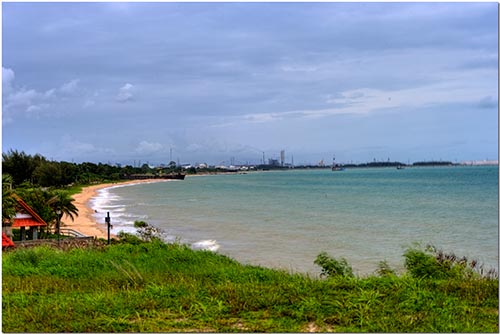
The technique used during capture is fairly simple. If you have a DSLR capable of at least four frames per second you can set your camera to auto bracketing, set it for 2/3’s of a stop between each exposure, put your camera in Av (aperture priority mode), meter as you would for a regular image, brace carefully, and with the single press of the shutter button you will capture three images 2/3’s of a stop apart. The critical part of this is twofold. You need excellent hand holding technique, and the aperture must always stay the same. And this only works on scenes without anything that moves fast like wind moving branches, moving water, or fast moving clouds. The scene must be nearly static.
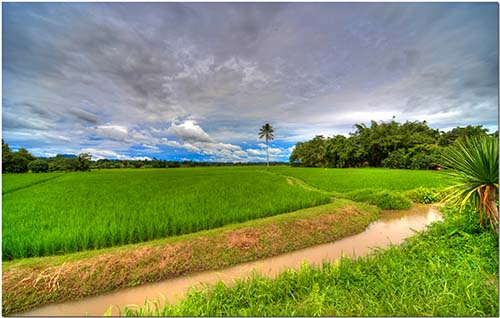
A better way is to carefully set up on a quality tripod, use mirror lockup, an external shutter release, meter for the aperture you want in manual mode, and then carefully take 5-8 images 2/3’s of a stop apart, 2-3 up, and 2-3 down from your original metering point. This will give you a wide range of exposures of the same scene to combine.
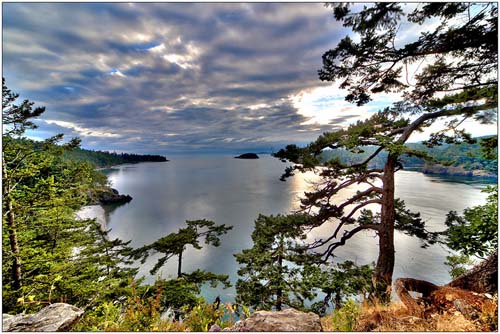
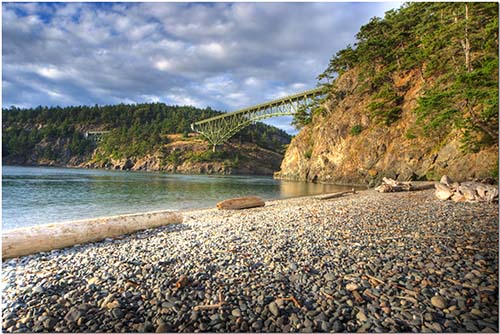
This last example (below) shows the rich tonal qualities of the best black and white film. It was captured by combining seven exposures in Photomatrix and then carefully tone mapping the resulting image. Notice the very wide range of tones? Using this technique you can create digital images that rival any film, or even exceed it.
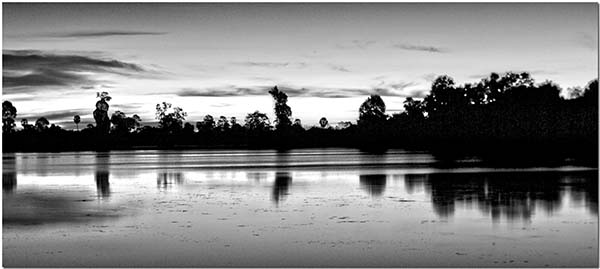
Photography News of Interest
The 50 Best Magazines for Photography? The Tempo staff evaluates and explains their choices. I found this very interesting. You can read the entire article here..
Ready for your big break into professional architectural photography? Sony sponsors what sounds like a very interesting program where you might catch your first break into the big time. Let us know if you make it! Read about it here..
Sony’s new Alpha DLSR-A900 is currently the resolution king for DSLRs. You might be interested in reading a full review here
Readers Submissions
This week we have a real treat. Akulka, a popular writer in the readers submission section visited the Democratic Peoples Republic of Korea (DPRK) and brought us back some great pictures. In the next two weeks Akulka will be a guest writer in the Outings section of this column followed by several in-depth submissions about his experiences in the Readers Submissions area. We are indeed fortunate to have one of our own share these unique experiences with us. Thank you Akulka!
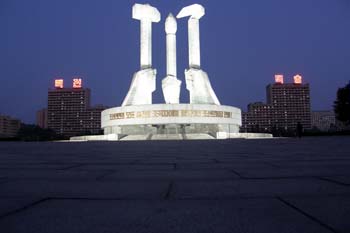
This 50-meter tall monument was erected in 1995 to mark the founding of the Workers Party of Korea. It tells of the proud history of the party which is composed of workers, peasants, and intellectuals, represented by the hammer, sickle, and brush.
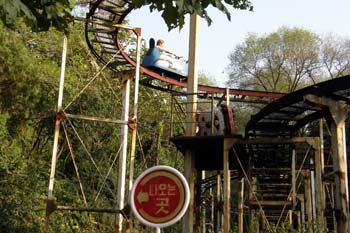
A roller coaster at Pyongyang’s centrally located funfair. Nothing for the faint-hearted, less because of the action packed ride it offers, but because of its decrepit rusty condition.
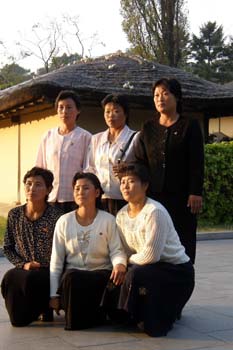
Pilgrims at Mangyongdae Revolutionary Site, where the “Great Leader” and father of the nation, Kim Il Sung, was born and spent his first few years.
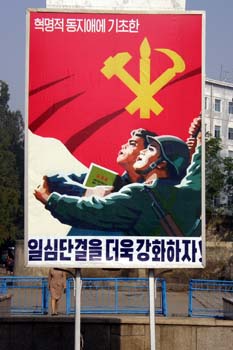
Not ads, but socialist propaganda posters dominate the cityscape in Pyongyang.
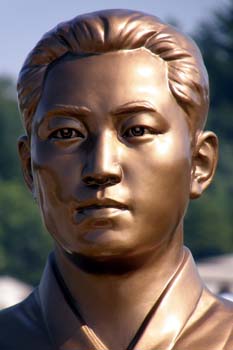
The bust of a fallen war hero at the Revolutionary Martyrs’ Cemetery.
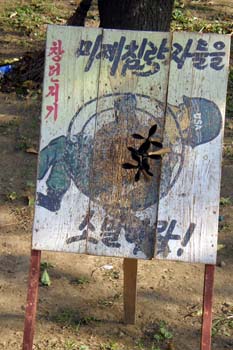
“Let’s annihilate the imperialistic US aggressors.” Throwing darts at GI’s at Pyongyang’s funfair.
I suspect the readers submissions will be a highly anticipated section of this column and I encourage anyone with photographs and travel accounts they d like to share to please send them to me at: QandA@Bkkimages.com
Readers' Questions
Phil is getting back into photography after what sounds like a long time away. His enthusiasm and excitement is contagious! I’m going to cut and paste some of this questions and my answers here in this section so hopefully anyone else with the same questions can benefit from them as well.
Steve – your site looks really great but when I click on any of the sub-titles up top – nothing happens. I don't think it is my computer because any other type of site I try it works ok. I have tried on many occasions and I still get the same result
Phil – My site is a flash site.. which means its operation is dependent not only on the way my site is built, but on the flash player add-on you’ve installed in your browser as well. Flash player add-on’s are known for being problematic.. which is one of the drawbacks to building a flash website.
Here’s what you need to do.
- Inside your browser, bring up my website, and when it stalls (that’s what it does when you can’t click on anything) and nothing is clickable.. hold down the control key and then hit F5. This will probably work. I visit a lot of websites each day and I reset 1-3 times a day when the site stalls. Using Microsoft Internet Explorer is more reliable, but Firefox and flash still has issues. I love Firefox though.. so I use it.
- If the above doesn’t work, simply go to Adobe.com and download their newest flash player add-on and install it. This will be Version 10. My site was built with version 9, but it should work with past/present versions.. but I’ve found that people running versions 7 and 8 have a lot of issues. Its good to upgrade to the newest version anyway.
Let me know how that goes ok?
I am working out whether or not to keep my F5 gear or sell it off. I still reckon film cameras are fun and get great results but I am not sure how much Velvia costs these days and processing. If I bring it can I still get access throughout Thailand to Velvia and E6? If so – what is the quality like? I don't want to sound horrible but when I lived there for those two years I was not impressed about anything done in Thailand. From house construction, to car service, to bookings to repairs it was all shite.
- Once you become competent with digital you’ll no longer shoot film. This happens to everyone. Digital is just so much easier, cheaper to shoot (once you buy the thing), and better quality.. you just stop using film.
- Thailand photo processers use the industry standard Fuji Frontier processing machines and these are very good. The problem is these are set up all week long for print film and they only run E-6 a few days a week. I find the quality very good for both and even the 11×14’s from this system are great.
The only thing I don't like about new digital cameras is that they cost the earth and have built-in obsolescence. Within a few yrs new technology has kicked in and your $3,000 body is suddenly worth about 300 bucks and you have to do the whole process all over again. Why don't they just make a componentry body where one can just plug in the upgrades over the years. Probably too simple for the boffins at Nikon and Canon.
- This is all true. This is why buying only what you need becomes even more important than before, you won’t be using it for years and years and getting your money’s worth out of it.
-
Excellent question. Contax years ago came out with a “digital back” DSLR.. but quickly failed. The main reason is that the “systems” in DSLR such as the autofocus, white balance sensor, metering, and more are contained all through the camera and these systems are still developing and getting better with each new model they put out. Sometimes the updates are incremental, sometimes huge. They couldn’t do this and still update the systems. Now, take the medium format cameras. For the most part these use the same AF, metering, etc, and rarely get updated. These cameras are mostly for the studio or landscape and are made to shoot slow and sure.. not fast paced for sports and journalism like DSLRs. So.. for years now they’ve made replaceable backs. However, even these get updates sometimes and more and more they’re going to matching bodies.. or a digital back that only works with certain bodies.
If I get one I will get the best (as I always do with gear). A D3 body only in Auss at the moment is worth over $7,000 – a hell of a lot of dough in anybody's book.
- The best is relative to your needs. The top model isn’t always the best for you and with Nikon this couldn’t be more true. For instance, the D700 and D3 are 99% the same camera. The same metering, same autofocus, same sensor, same weather sealing, and exact same image quality. The bigger differences are the D700 has a 95% viewfinder, the D3 100%. The D3 uses larger batteries and has more frames per second. There are other differences, but differences that would only make the huge extra cost, weight, and size a “best buy” for someone who must have those features. Otherwise, I’d rather carry the smaller and lighter and much cheaper D700..
If I did stick with film is it too expensive to do the whole film thing and then buy an expensive scanner to turn the hard copy transparencies into a file? Probably a bit to set up but if the quality was there a whole lot cheaper than buying a new system. I don't shoot editorial so I would not need the quick turn-around time. I used to wait until I had about 100 images before I sent them to Austral. They were very fussy and would maybe accept about 20 of them and I'd get the rest back. However after a few years I had a goodly number of transparencies with them and the money started to trickle in.
- Almost always the processing centers have the ability to scan at roughly a 8mp resolution, and more are adding capability to scan at up to 15mp’s. You pay a few extra bucks and you get a disk with your scans ready to go. Nice. You can still pay for drum scanning if you get a keeper.. and drum scanning still costs big money because as you know drum scanning is dependent on the operator and a good operator demands high pay.
- Check with Austral’s website and see if they list their requirements for submissions. I think you’ll find things have really changed.
Thanks so much for that Steve. I am rushing out to work now but will read that when I get home tonight.
Just one more question – and a very important one. How does one look after ones optics in the tropics?
Where I am in the dry desert here in Kalgoorlie WA, it is no problem at all. Nothing ever smells or goes musty and I have never had any fungus in my lenses. However after only two years of being in Chiang Mai, I came back and my beautiful 60mm Micro Nikkor was just full of it. I nearly died and haven't found a technician I can trust to fix it properly.
This is a real problem in Thailand and I am a bit loath to launch forth into buying expensive new lenses when this can happen. Will be interested to get your opinion on this one?
Cheers – Phi
-
I have over 30 expensive lenses from Nikon, Zuiko, Sigma, Zeiss, and Canon sitting in an open room here in Bangkok. It is not air conditioned or environmentally controlled in any way other than being inside my home. None of these lenses, some being decades old, have any signs of fungus or any other issues at all. The reason for this is:
- I keep them dry
- When I take them in the field I put them in large ziplocks and allow the temperature to adjust when I transit spaces where the temperature and humidity would rapidly change creating condensation. For instance, when leaving an air conditioned hotel into the hot Thailand outdoors.
- I regularly (every 60-90 days) inspect my lenses for any signs of fungus and would have them serviced at the first sign. This is almost embarrassingly inexpensive in Thailand at the factory service centers.
- Every few years I take my lenses in for regular cleaning and servicing, during which time they inspect the seals, thoroughly clean the inside/outside, inspect the autofocus mechanisms, check the rotation of focus and zoom rings, and more. Regular service will keep your lenses going strong for the next century.
Steve
Please submit your questions to QandA@Bkkimages.com All questions will be answered and most will show up in the weekly column.
A Snapshot of Bangkok Images Week in Review
A slow week for photography. I’ve been working on another project which has been taking a lot of my time, perhaps I’ll share this with you in the coming weeks.
Infocus Blog
Seeing Light.
Photography is simply a way of catching light and presenting it on film. Light in all its spectrums and wavelengths is mostly invisible to the human eye, but the part the human eye can see allows our normal sight and perhaps one of the most functional sets of eyes on earth.
Because sight comes naturally in our daily lives we really do little to improve it beyond getting regular checkups and perhaps prescription glasses or contacts. However, the real improvement in sight can come from training your brain to see light I ways you’ve always seen but maybe never noticed before. It takes years to train our eyes to instantly notice the direction of light, the temperature, and how it interacts with the scenes and objects we photograph. This is the single most important skill for a photographer and the skill that sets apart the top pros from everyone else.
This is an area in which I’m still learning and I suspect I’ll be improving on my ‘ability to see’ my entire life. Ansel Adams most famous works have been copied millions of times, but it was his ability to see and capture light during certain seasons, weather, and time of day that made his work so famous. Check out this website on Ansel Adams here.
Take whatever opportunities present themselves and see the light. For three years now I’ve lived in a high rise where I can stand on a certain balcony and watch the different types of light rise and fall over Bangkok during all the seasons, all types of weather, and all times of day and night. The contrasts are simply stunning! I started a journal describing the light and almost every week I add another entry as I train myself to ‘see’ the light falling on the city. Often when out in the field I’ll stop and sit for an hour or two watching the light change with the rising/setting sun, waiting for that special moment, and someone will sometimes ask “what are you doing just sitting there and not even taking your camera out yet?” I tell them: “I’m developing.. “



